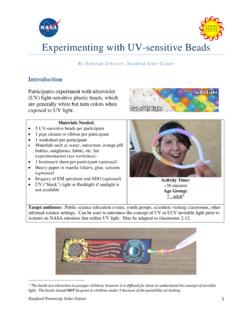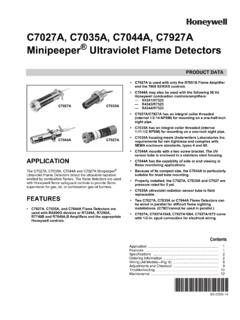Transcription of Environmental Control for Tuberculosis
1 Environmental Control for Tuberculosis : Basic Upper-Room ultraviolet Germicidal Irradiation Guidelines for Healthcare Settings Department of Health and Human Services Centers for Disease Control and Prevention National Institute for Occupational Safety and Health Environmental Control for Tuberculosis : Basic Upper-Room ultraviolet Germicidal Irradiation Guidelines for Healthcare Settings DEPARTMENT OF HEALTH AND HUMAN SERVICES. Centers for Disease Control and Prevention National Institute for Occupational Safety and Health This document is in the public domain and may be freely copied or reprinted. DISCLAIMER. Mention of any company or product does not constitute endorsement by the National Institute for Occupational Safety and Health (NIOSH). In addition, citations to Web sites external to NIOSH do not constitute NIOSH endorsement of the sponsoring orga- nizations or their programs or products. Furthermore, NIOSH is not responsible for the content of these Web sites.
2 ORDERING INFORMATION. To receive documents or other information about occupational safety and health topics, contact NIOSH at Telephone: 1 800 CDC INFO (1 800 232 4636). TTY: 1 888 232 6348. E-mail: or visit the NIOSH Web site at For a monthly update on news at NIOSH, subscribe to NIOSH eNews by visiting DHHS (NIOSH) Publication No. 2009 105. March 2009. TM. SAFER HEALTHIER PEOPLE. ii Environmental Control for Tuberculosis FOREWORD. T. uberculosis (TB) is a severe, contagious disease that primarily af- fects the lungs. It is usually transmitted from person to person via air- borne particles that contain TB bacteria. One of the major concerns for healthcare workers is the potential for transmission of TB at worksites from undiagnosed or unsuspected cases. Upper-room ultraviolet germicidal ir- radiation (UVGI) systems are considered a supplement or adjunct to other TB. infection- Control measures ( , ventilation) in settings where persons with undiagnosed TB could potentially contaminate the air ( , waiting rooms, emergency rooms, corridors, central areas).
3 Also, as an adjunct to negative pressure ventilation, upper-room UVGI can be used in rooms or areas where suspected or confirmed infectious TB patients are isolated or high-risk proce- dures are performed ( , bronchoscopy, sputum induction). Since 1997, CDC/NIOSH has conducted and funded studies to determine the ability of upper-room UVGI systems to kill or inactivate airborne mycobacte- ria in a simulated healthcare room. These studies have shown that a properly designed and maintained upper-room UVGI system may be effective in kill- ing or inactivating TB bacteria. Additional research still needs to be done in several areas including fixture installation and room irradiance measurements. However, sufficient laboratory information is now available to develop basic guidelines. This document makes information readily available to occupation- al safety and health professionals responsible for developing and implement- ing infection Control programs in healthcare settings.
4 Christine M. Branche, , Acting Director National Institute for Occupational Safety and Health Centers for Disease Control and Prevention Basic Upper-Room ultraviolet Germicidal Irradiation Guidelines for Healthcare Settings iii ABSTRACT. A. lthough the number of cases of Tuberculosis (TB) in the United States has declined in the last several years, there is still a continuing need to protect healthcare workers and the public from risk of infection. One of the primary risks to healthcare workers and the public is exposure to persons with unsuspected or undiagnosed infectious TB. Exposures of this type may occur in areas such as waiting rooms, corridors, or emergency rooms in healthcare facilities ( , hospitals, correctional institutions, nursing homes, clinics). While mechanical ventilation systems may provide protec- tion to workers in these situations, there are limitations such as Environmental constraints, cost, and comfort considerations.
5 In 1997, the Centers for Disease Control and Prevention (CDC), National Institute for Occupational Safety and Health (NIOSH) awarded a contract to the University of Colorado to evalu- ate the ability of a well-designed and thoroughly characterized upper-room ultraviolet germicidal irradiation (UVGI) system to kill or inactivate airborne mycobacteria. A number of parameters were evaluated during the study. These included (1) the irradiance level in the upper room that provides a UVGI dose over time that kills or inactivates an airborne surrogate of Mycobacterium tu- berculosis, (2) how to best measure UVGI fluence levels, (3) the effect of air mixing on UVGI performance, (4) the relationship between mechanical ventilation and UVGI systems, (5) the effects of humidity and photoreactiva- tion (PR), and (6) the optimum placement of UVGI fixtures. The completed research indicates that an appropriately designed and maintained upper-room UVGI system may kill or inactivate airborne TB bacteria and increase the protection afforded to healthcare workers while maintaining a safe level of UVGI in the occupied lower portion of the room.
6 Additional research still needs to be done to better plan effective upper-room UVGI fixture installation considering variables such as air mixing and measurement of the average UV. fluence rate in the upper room. However, sufficient laboratory information is now available to develop these guidelines. This document is designed to provide information to healthcare managers, facility designers, engineers, and industrial hygienists on the parameters necessary to install and maintain an effective upper-room UVGI system. iv Environmental Control for Tuberculosis EXECUTIVE SUMMARY. A. irborne transmission of Mycobacterium Tuberculosis is a known risk to healthcare workers. In 1994, the Centers for Disease Control and Prevention (CDC) updated guidelines for preventing the transmission of M. Tuberculosis in healthcare facili- ties. The guidelines were issued in response to a resurgence of Tuberculosis (TB) that oc- curred in the United States from the mid-1980s through the early 1990s.
7 The guidelines were based on a risk process that classified healthcare facilities according to categories of risk with a related series of administrative, Environmental , and respiratory protection controls. The TB infection Control measures specified in the 1994 CDC document were implement- ed by many healthcare facilities in the United States. These measures helped decrease the transmission of M. Tuberculosis to patients and healthcare workers in healthcare facilities. However, despite the decline in TB rates in the United States in recent years, there is still a continuing need to protect healthcare workers from the risk of infection. For example, healthcare workers in different areas face varied risks. In Idaho, the case rate was per 100,000 in 2004, while in the District of Columbia the rate was per 100,000. The 1994 CDC guidelines were primarily aimed at hospital-based facilities. In 2005, CDC. reevaluated the risk of TB transmission to healthcare workers and developed new guide- lines.
8 These guidelines are intended to eliminate the lingering threat to healthcare workers that is primarily from patients or others who have unsuspected and undiagnosed infec- tious TB. Exposures of this type may occur in areas such as waiting rooms, corridors, or emergency rooms in healthcare facilities ( , hospitals, correctional institutions, nursing homes, clinics). The use of ultraviolet germicidal irradiation (UVGI) in the upper portion of rooms or areas is an Environmental Control measure that may be effective in killing or inactivating air- borne M. Tuberculosis generated by persons with unknown or unsuspected infectious TB. There was concern regarding the efficacy of this Control measure when CDC updated the healthcare facility guidelines in 1994. Therefore, in 1997, the CDC's National Institute for Occupational Safety and Health (NIOSH) awarded a contract to the University of Colo- rado to evaluate the ability of a well-designed and thoroughly characterized upper-room UVGI system to kill or inactivate an airborne surrogate of M.
9 Tuberculosis . A number of parameters were evaluated during the study. These included (1) the UV fluence rate needed to inactivate M. Tuberculosis surrogates, (2) the way to best measure UVGI fluence rates, (3) the effect of air mixing on UVGI performance, (4) the relationship between mechanical ventilation and UVGI systems, (5) the effects of humidity and photoreactivation (PR), and (6) the optimum placement of UVGI fixtures. The completed research and other research studies that have recently been published clearly indicate that an appropriately designed and maintained upper-room UVGI system may kill or inactivate airborne TB bacteria and significantly increase the protection afforded to healthcare workers while maintaining a safe level of UVGI in the occupied lower portion of the room. Additional research needs Basic Upper-Room ultraviolet Germicidal Irradiation Guidelines for Healthcare Settings . to be done to better plan effective upper-room UVGI fixture installations in healthcare set- tings considering variables such as air mixing and measurement of UV fluence levels in the upper room.
10 However, sufficient laboratory information is now available to develop basic guidelines. The purpose of this document is to examine the different parameters necessary for an effec- tive upper-room UVGI system and to provide this information to occupational safety and health professionals responsible for developing and implementing infection Control pro- grams in healthcare settings. These guidelines are consistent with previous CDC healthcare guidelines and expand upon them. Guidelines Factors Influencing Effectiveness of Upper-Room UVGI Systems 1. UVGI Irradiance and Dose Factors that must be considered when evaluating the ability of an upper-room UVGI system to kill or inactivate airborne microorganisms include the sensitivity of the microorganisms to UVGI and the dose of UVGI received by a microorganism or population of microorgan- isms. UVGI dose is the ultraviolet (UV) irradiance multiplied by the time of exposure and is usually expressed as W s/cm2.

















